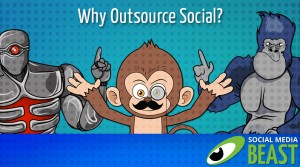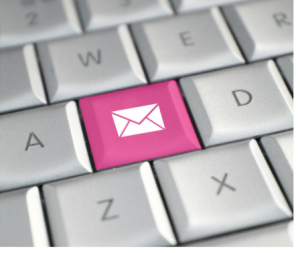Are you looking for a new job? A raise? A promotion?
Do you want to build influence in your field?
You can achieve all of the above if you prove yourself with your personal brand.
Despite having a full-time job, your personal brand is worth your time because it builds upon your skills and knowledge. Employers want to see your abilities, not just hear you talking about them.
Along with being active on social media and networking, you might also want to consider publishing your own original content on your website.
Let me take a step back for a moment. Before getting started on a blog, you need to know how to start your personal brand overall. Allow me to direct your attention to my previous article on this subject: Personal Branding: Do You Stand Out?
Look at that article first if you’re just getting started with personal branding.
Next, I need to clarify something important:
There’s a difference between a personal blog and a personal branding blog.
Consider your personal brand your professional image. Your personal blog can be similar to a diary, but a branding blog should focus on your career or field/industry.
With this article, I guide you from the very beginning in blog development. I help you get started from scratch and lead you through your very first post.
Here is a summary of what I will discuss:
- Understanding your blog’s purpose
- Developing your own public image
- Building your blog itself
- Establishing your website’s baseline content
- Get active on social media and build relationships
- Write your very first post
After all that is done, I give you the next steps, resources and key takeaways to bring with you when you get started on your own.
Any questions or other input would be wonderful, so please leave a comment below! You can also reach out to me by email anytime.
———
1) Understand your blog’s purpose
Hopefully, you know why you’re working on your personal brand. You may even have an established mission statement and goals for your activity.
But do you have those two essential elements written out for your blog?
Just like with your overall brand, your blog should have a mission statement and goals to reach. Otherwise, you’ll just be wandering aimlessly through the vast blogosphere with no direction or drive.
Julie Neidlinger of CoSchedule wrote an informative article on developing a blog mission statement that goes more in-depth than I do here: How To Write A Mission Statement For Your Blog.
I, myself, found this article immensely helpful. Julie goes into detail with the questions I should ask myself about my blog and how to answer them in ways that can work as a concise, practical mission statement.
If you need help narrowing down your thoughts into a useful mission statement, this CoSchedule article is for you.
After reading it, I’ve created my own mission statement, one that I will continue to adjust as needed over time:
My blog is designed to bring my own experience and the knowledge of others in the marketing field to the rest of our community in order to benefit my audience in ways they could not find elsewhere. I want to build my influence in marketing through my contributions in the various subtopics, such as blogging, social media marketing and email marketing. I will commit to publishing one well-written, high-quality article a week and publicize it accordingly to bring my work to others’ attention.
Even with a mission statement, you still need to have well-thought-out goals, which you should write down and save for future reference and adjustments.
There are many ways you can develop your goals. I, personally, like to go by the S.M.A.R.T. method:
Specific
Measurable
Attainable
Relevant
Timely
Although following this approach could take a lot of time and tweaking, it’s the best way to ensure you reach your goal. When I first started my blog, I didn’t have set goals, and my efforts went to waste as a result.
Not long later, I did some research on goal-setting, and these resources helped me out the most:
From Wikihow: How to Set SMART Goals
It gives you detailed steps for each letter of the acronym.
From Shareaholic: How to Set Blogging Goals You Can Actually Achieve
This article includes 5 ways to set and achieve your goals, including creating SMART ones and staying committed.
More recently, I found this article by Problogger: Setting Goals: Why You Need Them, and How to Write Them
I like this article because it’s detailed, including the why and how to make practical goals.
When I started writing out goals, I had too many of them. My efforts to follow the SMART technique for all of them made the process very lengthy, killing far too much of my time.
The above articles (with lots of practice and lessons learned) gave me the ability to narrow down, focus and build upon goals I could actually work with efficiently.
Do you have a mission statement for your blog? What are the goals you hope to achieve? Share them in a comment below!
———
2) Develop your own public image
I made the mistake of skipping this crucial step until after step 3 below. Although you don’t have an actual blog platform yet, it’s good to get this all ready to go beforehand because it’ll give you a better idea of what design theme you’ll want to use.
Your website should have your name in a very prominent location, ideally in the domain name as well. You might want to go by a pen name or nickname, but I don’t recommend it for a personal branding blog. Your formal, full name would be best because that’s how employers and other interested parties will be looking for you.
My website has my name listed prominently on the top of every page as the header. It ensures that people know who runs the website and that they’re in the right place.
Below your name, I recommend you add a tagline of sorts that describes who you are and what you want to be known for. It should be brief and memorable. If you have a LinkedIn account, have your tagline be the same or similar on your profile and website for consistency.
My website tagline is:
Blogger | Social Media Marketer | Overall Marketing Extraordinaire
With your name and tagline, your blog should definitely have a picture of you or maybe a professionally designed logo. Ideally, it should be your picture because visitors are going to want to see what you look like when they reach your homepage.
If you want to keep your photo reserved for your About page, a logo here would work, but it isn’t ideal for a personal branding blog.
Learn more about what makes for a great professional photo in Buffer’s article: The Research and Science Behind Finding Your Best Profile Picture.
Buffer’s article focuses on one’s social media profile picture, but it gives a lot of great advice about finding and creating professional photos that look good and work well.
Are you using your real name or a pen name for your blog? What is your tagline? Share it with us in a comment below!
———
3) Build your blog itself
Now it’s time to get to the nitty gritty and build your website itself. This is when you’ll need to choose a platform, buy your domain name and host account, and choose a design theme.
You’ll probably hear this a lot: WordPress.org (NOT .com) is the best way to go. WordPress is hands-down the most popular blogging platform, and it has tons of features to back that up:
- Widgets
- Plugins
- Themes
If you don’t want to go with WordPress, there’s also a few other options worth trying out:
Once you have your platform chosen, you should buy your domain name and find a hosting service. Having a free account is nice, but it doesn’t look professional to have “www.xyz.wordpress.com” as your domain.
Ideally, your domain should be your name, especially if it’s short. I bought my name (www.annaliesehenwood.com) and my main domain (www.mktginnovator.com), and both lead to the latter.
PC Mag provided a comparison chart of some of the leading domain hosts for you to evaluate based upon your own needs.
I would recommend you choose your hosting service wisely. I found this article by PC Mag after I had already signed up with a service, and I was greatly disappointed with it. It was also a big pain to switch to a new service without extra costs and wasted money.
Also consider checking out Google’s domain hosting service as well because it seems like a great alternative to the more expensive services out there.
Ultimately, you need to do the necessary research and go with a domain name and hosting service that fits well for you.
Finally, once you have your platform of choice and domain name purchased and hosted, you need to pick a design theme that fits with who you are and how you want your site to appear.
Again, your best bet is to purchase a professional theme right away rather than using one of the free designs. You’ll have more features and flexibility, which you’ll really want in the end. However, I must say that you need to choose very wisely here as well. Changing themes can take a lot of work, and it’ll cause an extensive amount of website downtime while you adjust.
If you’re going to change themes, change it really early on.
What platform are you thinking of using for your blog? Do you know what your domain name will be? Share your info in a comment below!
———
4) Establish your website’s baseline content
Before you delve into writing, you need to have all your baseline content in order. This includes your…
Your About page should be where you tell your story. It’s where you can be more personal and conversational about what you feel passionate about as well as what you hope to achieve with your blog.
Don’t get into your professional history here. Save that for your portfolio page(s).
On your About page, you want to show your visitors who you are as a person. Be genuine and interesting, and your visitors will be able to relate to you more.
All websites should have a page where people can contact you directly. It can have multiple means listed, such as:
- Email
- Phone
- Mailing address
- Contact form
When it comes to a personal branding blog though, a contact form would suffice. If you want to add your email address or phone number, be mindful of spammers. Don’t spell out your email address but rather make it a hyperlink. Ex. mailto:xyz@xyz.com
I wouldn’t recommend adding your personal address. It’s better to be safe than sorry.
Next comes your portfolio. This can be one page or several, depending on what you want to share. If you have a long list of items, create different pages based upon themes or categories. If you’re new to your career, a single page would be fine.
Some examples of portfolio sub-pages are:
- Work history
- Career references / testimonials
- Leadership / volunteering
- Passions / skills / interests
Your portfolio is similar to your resume and basically a more in-depth version of your LinkedIn profile (if you have one, which you really should).
Interested in learning more about designing your blog website? Blogger Sidekick has an article on The Ultimate Guide to Effective Blog Design worth checking out for a more thorough explanation of each website element.
Do you have your baseline content ready to go? What pages have you added, included or excluded from my list? Share your thoughts in a comment below!
———
5) Get active on social media and build relationships
At this stage, you don’t yet have content of your own to share. This is the time for you to build relationships by sharing the content of and communicating directly with influencers in your field on social media.
Before you get to writing your own content, subscribe to other blogs and follow other people / brands on social media. Buffer provides a list of great sources and tools for content you can share, and the list really is helpful for when you want help with this.
Read a lot from others, and when you find content you especially enjoyed or agreed with, share it. Just don’t forget to formally mention the authors and sources when you share. Otherwise, they won’t get notified that they were publicized.
A large part of maintaining a blog for your personal brand is reading what others are saying and advising. You should dedicate as much time as you can for doing this because it’ll give you the knowledge to build your own blog just as much as give you the content to share.
Even when you don’t have your own content to share, you can still start the process of relationship building on social media.
- Reply or comment on influencers’ activity.
- Share their work.
- Follow influencers and thank users for following you.
Not sure who to follow on social media? If you’re looking for leaders in content marketing, look no further than this list of the 2015 top 100 influencers and brands collected by Onalytica. I found this list incredibly helpful with my own efforts, and it’s updated yearly to ensure relevance.
If you aspire to be on that list, pay attention to the people already on there. What are they doing that is getting them noticed? What are they sharing? Find out these things and you’ll be one step closer to being on that list in the future.
Do you subscribe to other blogs or follow specific influencers on social media? What do you do to find the content you share? What social media platforms have you found most effective for personal branding? Share your answers in a comment below!
———
6) Write your first post
Okay, it’s finally that time when you can sit down and write your first article.
Are you ready?
It’s normal for a little anxiety to grab you and shake you up a bit. I would be surprised if you weren’t a little nervous. Your first post is part of the very foundation you’ve worked so hard to build.
Spokal has an article on how to overcome your fears from your first blog post, and it has some great tips in it to help you quell that anxiety you’re feeling.
Your first post should get you rolling on the right foot, so to speak. Write about something that fits with your overall focus and gives readers a glimpse of what your articles are going to be like in the future.
It should be of high-quality and more valuable to your reader than yourself. If you’re not sure what to write about or don’t have the experience it requires, do what I do and include the advice and input from other blogs, but make sure you cite them properly.
After you have a finalized and published post, share it on social media. Tell the people and brands you cited that you included them in your article. This’ll bring a lot more traffic to your blog.
What are you writing about for your first post? What will be the format of your post (list, curated, open letter, checklist…)? Share your ideas in a comment below!
———
Next steps
There’s so much more to building your blog that I don’t get to here. I’ve listed a few of those topics below, and stay tuned for future articles discussing them in depth:
- Building your email subscriber list and developing your newsletter
- How to be successful with guest blogging
- How to sign up for and make the most out of blog syndication
- Best practices for blog post promotion on social media
———
Resources
For Gaining Website Traffic:
CoSchedule: How To Get A High-Traffic Blog Even If You’re Blogging Solo
For Finding and Making Blog Images:
WordStream: Ultimate Guide to Finding, Customizing and Using Free Images for Blogs
For Idea Development:
Annaliese Henwood: Content Generator Tools
For Overcoming Writer’s Block:
Content Marketing Institute: 10 No-Cost Tools to Help You Conquer Writer’s Block
Boost Blog Traffic: 101 Writing Resources That’ll Take You from Stuck to Unstoppable
For Measurement:
Boost Blog Traffic: A Crash Course in Google Analytics for Anyone Who’s Sick of Feeling Like an Idiot
Helpful Tools:
———
Key takeaways
- Be consistent – Publish articles regularly and on a schedule
- Be flexible – Allow for changes over time
- Be human – Tell your story and give your opinion
- Be aware – know what your readers want and what’s trending in your field
- Be positive – you’ll make mistakes and things will go wrong, but don’t lose your drive to continue
———
Now, go get’em and get writing!
Digital & Social Articles on Business 2 Community(200)
Report Post







